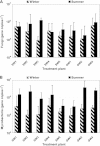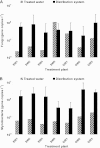Nontuberculous mycobacteria, fungi, and opportunistic pathogens in unchlorinated drinking water in The Netherlands
- PMID: 23160134
- PMCID: PMC3568566
- DOI: 10.1128/AEM.02748-12
Nontuberculous mycobacteria, fungi, and opportunistic pathogens in unchlorinated drinking water in The Netherlands
Abstract
The multiplication of opportunistic pathogens in drinking water supplies might pose a threat to public health. In this study, distributed unchlorinated drinking water from eight treatment plants in the Netherlands was sampled and analyzed for fungi, nontuberculous mycobacteria (NTM), and several opportunistic pathogens by using selective quantitative PCR methods. Fungi and NTM were detected in all drinking water samples, whereas Legionella pneumophila, Pseudomonas aeruginosa, Stenotrophomonas maltophilia, and Aspergillus fumigatus were sporadically observed. Mycobacterium avium complex and Acanthamoeba spp. were not detected. Season had no influence on the occurrence of these organisms, except for NTM and S. maltophilia, which were present in higher numbers in the summer. Opportunistic pathogens were more often observed in premise plumbing water samples than in samples from the distribution system. The lowest number of these organisms was observed in the finished water at the plant. Thus, fungi, NTM, and some of the studied opportunistic pathogens can multiply in the distribution and premise plumbing systems. Assimilable organic carbon (AOC) and/or total organic carbon (TOC) had no clear effects on fungal and NTM numbers or on P. aeruginosa- and S. maltophilia-positive samples. However, L. pneumophila was detected more often in water with AOC concentrations above 10 μg C liter(-1) than in water with AOC levels below 5 μg C liter(-1). Finally, samples that contained L. pneumophila, P. aeruginosa, or S. maltophilia were more frequently positive for a second opportunistic pathogen, which shows that certain drinking water types and/or sampling locations promote the growth of multiple opportunistic pathogens.
Figures



Similar articles
-
Source-to-tap investigation of the occurrence of nontuberculous mycobacteria in a full-scale chloraminated drinking water system.Appl Environ Microbiol. 2024 Sep 18;90(9):e0060924. doi: 10.1128/aem.00609-24. Epub 2024 Aug 7. Appl Environ Microbiol. 2024. PMID: 39109876 Free PMC article.
-
Pyrosequence analysis of the hsp65 genes of nontuberculous mycobacterium communities in unchlorinated drinking water in the Netherlands.Appl Environ Microbiol. 2013 Oct;79(19):6160-6. doi: 10.1128/AEM.01591-13. Epub 2013 Aug 2. Appl Environ Microbiol. 2013. PMID: 23913420 Free PMC article.
-
Opportunistic Pathogens in Drinking Water Distribution Systems-A Review.Microorganisms. 2024 Apr 30;12(5):916. doi: 10.3390/microorganisms12050916. Microorganisms. 2024. PMID: 38792751 Free PMC article. Review.
-
Molecular survey of the occurrence of Legionella spp., Mycobacterium spp., Pseudomonas aeruginosa, and amoeba hosts in two chloraminated drinking water distribution systems.Appl Environ Microbiol. 2012 Sep;78(17):6285-94. doi: 10.1128/AEM.01492-12. Epub 2012 Jun 29. Appl Environ Microbiol. 2012. PMID: 22752174 Free PMC article.
-
Current Epidemiologic Trends of the Nontuberculous Mycobacteria (NTM).Curr Environ Health Rep. 2016 Jun;3(2):161-7. doi: 10.1007/s40572-016-0086-z. Curr Environ Health Rep. 2016. PMID: 27020801 Review.
Cited by
-
Source-to-tap investigation of the occurrence of nontuberculous mycobacteria in a full-scale chloraminated drinking water system.Appl Environ Microbiol. 2024 Sep 18;90(9):e0060924. doi: 10.1128/aem.00609-24. Epub 2024 Aug 7. Appl Environ Microbiol. 2024. PMID: 39109876 Free PMC article.
-
Drinking Water Microbiota, Entero-Mammary Pathways, and Breast Cancer: Focus on Nontuberculous Mycobacteria.Microorganisms. 2024 Jul 13;12(7):1425. doi: 10.3390/microorganisms12071425. Microorganisms. 2024. PMID: 39065193 Free PMC article. Review.
-
Implications of Climate Change: How Does Increased Water Temperature Influence Biofilm and Water Quality of Chlorinated Drinking Water Distribution Systems?Front Microbiol. 2021 Jun 8;12:658927. doi: 10.3389/fmicb.2021.658927. eCollection 2021. Front Microbiol. 2021. PMID: 34168627 Free PMC article.
-
Drug Resistance in Nontuberculous Mycobacteria: Mechanisms and Models.Biology (Basel). 2021 Jan 29;10(2):96. doi: 10.3390/biology10020096. Biology (Basel). 2021. PMID: 33573039 Free PMC article. Review.
-
Impact of Water Chemistry, Pipe Material and Stagnation on the Building Plumbing Microbiome.PLoS One. 2015 Oct 23;10(10):e0141087. doi: 10.1371/journal.pone.0141087. eCollection 2015. PLoS One. 2015. PMID: 26495985 Free PMC article.
References
-
- Bartram J, Cotruvo C, Exner M, Fricker C, Glasmacher A. 2003. Heterotrophic plate counts and drinking-water safety. IWA Publishing/World Health Organization, London, United Kingdom
-
- Garcia-Nuńez M, Sopena N, Ragull S, Pedro-Botet ML, Morera J, Sabria M. 2008. Persistence of Legionella in hospital water supplies and nosocomial Legionnaires' disease. FEMS Immunol. Med. Microbiol. 52:202–206 - PubMed
-
- Luck PC, Schneider T, Wagner J, Walther I, Reif U, Weber S, Weist K. 2008. Community-acquired Legionnaires' disease caused by Legionella pneumophila serogroup 10 linked to the private home. J. Med. Microbiol. 57:240–243 - PubMed
-
- Rusin PA, Rose JB, Haas CN, Gerba CP. 1997. Risk assessment of opportunistic bacterial pathogens in drinking water. Rev. Environ. Contam. Toxicol. 152:57–83 - PubMed
-
- van der Kooij D, Veenendaal HR, Scheffer WJ. 2005. Biofilm formation and multiplication of Legionella in a model warm water system with pipes of copper, stainless steel and cross-linked polyethylene. Water Res. 39:2789–2798 - PubMed
Publication types
MeSH terms
Substances
LinkOut - more resources
Full Text Sources
Medical
Molecular Biology Databases
Miscellaneous

